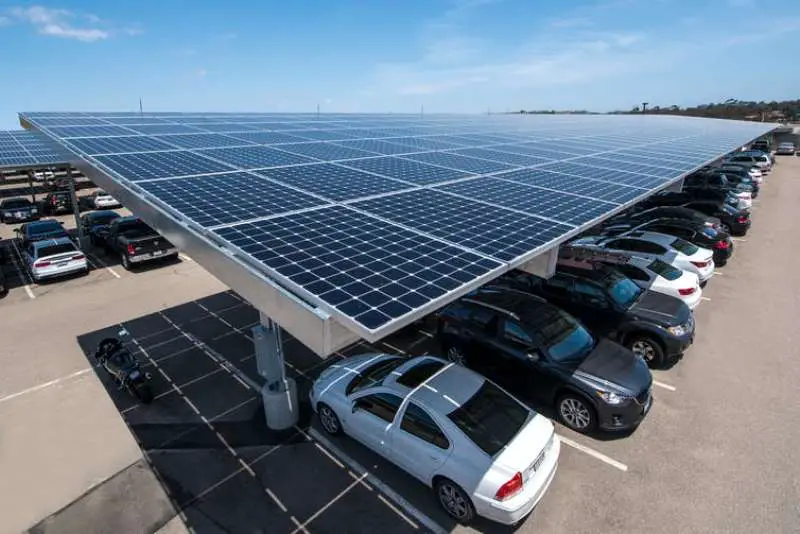We know how much you residential solar owners (or soon-to-be owners) love to figure out (and compare) solar panel power output; it is, after all, something worth knowing. But what about the energy output of an entire array, say, 40 solar panels worth?
Well, 400-watt monocrystalline panels are the most popular panels in the U.S. market. A 40 solar panel system with this configuration will have a nameplate capacity of 16kWh, which, quite frankly, is more than what you might require.
The thing is, that’s just one scenario, and we all know how solar plate capacity and location can influence energy production.
So on that note, let’s look into this matter further.
How Much Energy Will 40 Solar Panels Produce?

To answer this question, you need to do the following:
- Compare your consumption against a system’s capabilities (we’ll look into this shortly).
- Determine the type of solar panels this 40 solar panel system will use. Remember: panels come with different power ratings, built-material, and prices.
- Consider your location; this has a considerable effect on production capacity. For example, the same solar system will produce twice as much power in Arizona than in Alaska. (We’ll go into these calculations shortly)
Step 1: Calculate Your Domestic Needs
There are two ways for you to determine your households power requirements:
- Refer to the power supply company’s bill
- Read up on the power consumption of major appliances
We recommend the first option, even if you’re considering a new place. In this method, you tally your power consumption for the last year and add it up. Note this number down.
The second method requires you to read up on your appliance ratings.
For example, a small refrigerator is rated at 130 watts (see below) and might take 2-3 kWh daily. So, add the various appliance power ratings to determine your consumption.
Note the final usage (kWh) somewhere; you’ll return to this later.
Step 2: Select The Solar Panels
The second step involves the selection of solar panels. As previously mentioned, there are two factors to be aware of here: panel type and power rating.
There are several panel types, including polycrystalline, monocrystalline, and thin-film.
Monocrystalline panels have the highest efficiency (18 to 24%) but usually cost the most.
Next up are power ratings (this affects panel size). Solar panels come in various sizes, such as 50W, 100W, 200W, 400W, 500W and 600W.
Now that you have the key panel data, you can select the ones you’re most interested in and compare prices.
Step 3: Define The location
Location is probably the most significant factor when it comes to solar panel output since solar irradiance is not equally available across all areas.
Using Peak Sun Hours (PSH) helps you determine how long the sun has been at an intensity of 1 kW/m2. You can find your areas PSH by using Global Solar Atlas.
Once you’ve found your PSH, write it down (this is very important).
Step 4: Number Crunching – 40 Solar Panels
You’ll use the Peak Sun Hour method to calculate the energy produced by these 40 solar panels. The formula is as follows:
Estimated Annual Energy (in kWh) = Rated System Power Output (in kW) x (PSH hours x 365 days)
Rated System Power Output (in kW) = No. of Panels x power rating of a single panel
Working Example
- Panel type and power rating: 400-watt Monocrystalline panels
- location: Arizona with 5.7 h PSH
The estimated annual energy output would be 33,288 kWh.
Remember, your requirement may vary depending on why you want a solar system. This could be 50% if you plan to only power your house via solar during the day or 100% if you want a backup at night (or want to sell energy to the grid).
How Much Power Will 40 Solar Panels Have?

So, we just covered solar energy. How is it different from power? In simple terms, solar energy is how much electricity has been generated over a specific period.
For instance, we used the Arizona example and calculated the annual solar energy generated from 40 400-watt solar panels.
In contrast, power is defined as the capacity to deliver energy; in this case, we use peak power.
The following table shows 40- solar panel arrays with differently rated panels:
| Number Of Panels | Nameplate Rating | Total Power Capacity |
|---|---|---|
| 40 Solar Panels | 50 watt | 2 kW |
| 40 Solar Panels | 100 watt | 4 kW |
| 40 Solar Panels | 200 watt | 8 kW |
| 40 Solar Panels | 300 watt | 12 kW |
| 40 Solar Panels | 400 watt | 16 kW |
| 40 Solar Panels | 500 watt | 20 kW |
| 40 Solar Panels | 600 watt | 24 kW |
Rated System Power Output (in kW) = No. of Panels x power rating of a single panel
How Much Space Do You Need For 40 Solar Panels?
Knowing your space requirements is crucial when solar panels. Why? Because solar panels are one of the most space-intensive power units.
The table below provides you with spatial requirements for various solar arrays:
| Nameplate Rating | Estimate sizes | Total space required |
|---|---|---|
| 50 watt | 2.2 ft. x 1.4 ft. | 123 ft2 |
| 100 watt | 3.9 ft. x 1.7 ft. | 265 ft2 |
| 200 watt | 4.8 ft. x 2.2 ft. | 422 ft2 |
| 400 watt | 6.5 ft. x 3.2 ft. | 832 ft2 |
| 500 watt | 7.5 ft. x 3.7 ft. | 1,110 ft2 |
| 600 watt | 8 ft. x 3.7 ft. | 1,184 ft2 |
For Arizona example, the total space required would be 832 ft2 + 25% = 1,040ft2.
How Much Will 40 Solar Panels Cost?
Cost is an essential consideration for any project, and solar energy projects are no different. A ballpark figure would be USD 2.94 per watt in the USA, but this is only an estimate since various factors affect the pricing the solar panels:
- Solar Panels: Different OEMs have different prices for their SKUs;
- Solar Panel Support: These might include mounts for solar arrays on the roof or in the backyard;
- Engineering And Installation Costs: These include costs for the design and installation of the panels;
- Electrical BOS: this consists of the meter, communication device, subpanels, wiring, etc.
Final Thoughts
We hope that we’ve answered most of your questions regarding the topic.
The key wake away for you to remember, is that solar panel energy production is completely dependent on where you live, and how much solar irradiance you receive.





































































